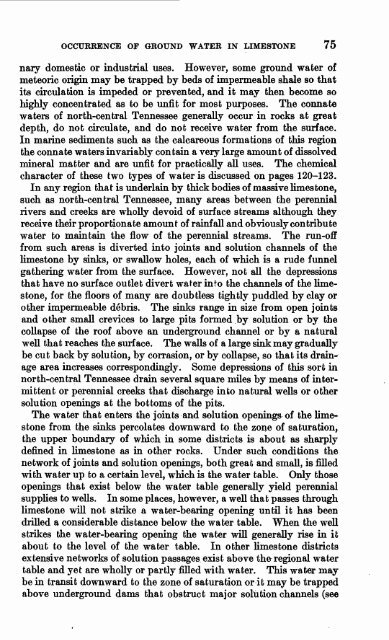GROUND WATER IN NORTH-CENTRAL TENNESSEE
GROUND WATER IN NORTH-CENTRAL TENNESSEE
GROUND WATER IN NORTH-CENTRAL TENNESSEE
Create successful ePaper yourself
Turn your PDF publications into a flip-book with our unique Google optimized e-Paper software.
OCCURRENCE OF <strong>GROUND</strong> <strong>WATER</strong> <strong>IN</strong> LIMESTONE 75<br />
nary domestic or industrial uses. However, some ground water of<br />
meteoric origin may be trapped by beds of impermeable shale so that<br />
its circulation is impeded or prevented, and it may then become so<br />
highly concentrated as to be unfit for most purposes. The connate<br />
waters of north-central Tennessee generally occur in rocks at great<br />
depth, do not circulate, and do not receive water from the surface.<br />
In marine sediments such as the calcareous formations of this region<br />
the connate waters invariably contain a very large amount of dissolved<br />
mineral matter and are unfit for practically all uses. The chemical<br />
character of these two types of water is discussed on pages 120-123.<br />
In any region that is underlain by thick bodies of massive limes tone,<br />
such as north-central Tennessee, many areas between the perennial<br />
rivers and creeks are wholly devoid of surface streams although they<br />
receive their proportionate amount of rainfall and obviously contribute<br />
water to maintain the flow of the perennial streams. The run-off<br />
from such areas is diverted into joints and solution channels of the<br />
limestone by sinks, or swallow holes, each of which is a rude funnel<br />
gathering water from the surface. However, not all the depressions<br />
that have no surface outlet divert water info the channels of the lime<br />
stone, for the floors of many are doubtless tightly puddled by clay or<br />
other impermeable debris. The sinks range in size from open joints<br />
and other small crevices to large pits formed by solution or by the<br />
collapse of the roof above an underground channel or by a natural<br />
well that reaches the surface. The walls of a large sink may gradually<br />
be cut back by solution, by corrasion, or by collapse, so that its drain<br />
age area increases correspondingly. Some depressions of this sort in<br />
north-central Tennessee drain several square miles by means of inter<br />
mittent or perennial creeks that discharge into natural wells or other<br />
solution openings at the bottoms of the pits.<br />
The water that enters the joints and solution openings of the lime<br />
stone from the sinks percolates downward to the zone of saturation,<br />
the upper boundary of which in some districts is about as sharply<br />
defined in limestone as in other rocks. Under such conditions the<br />
network of joints and solution openings, both great and small, is filled<br />
with water up to a certain level, which is the water table. Only those<br />
openings that exist below the water table generally yield perennial<br />
supplies to wells. In some places, however, a well that passes through<br />
limestone will not strike a water-bearing opening until it has been<br />
drilled a considerable distance below the water table. When the well<br />
strikes the water-bearing opening the water will generally rise in it<br />
about to the level of the water table. In other limestone districts<br />
extensive networks of solution passages exist above th& regional water<br />
table and yet are wholly or partly filled with water. This water may<br />
be in transit downward to the zone of saturation or it may be trapped<br />
above underground dams that obstruct major solution channels (see

















